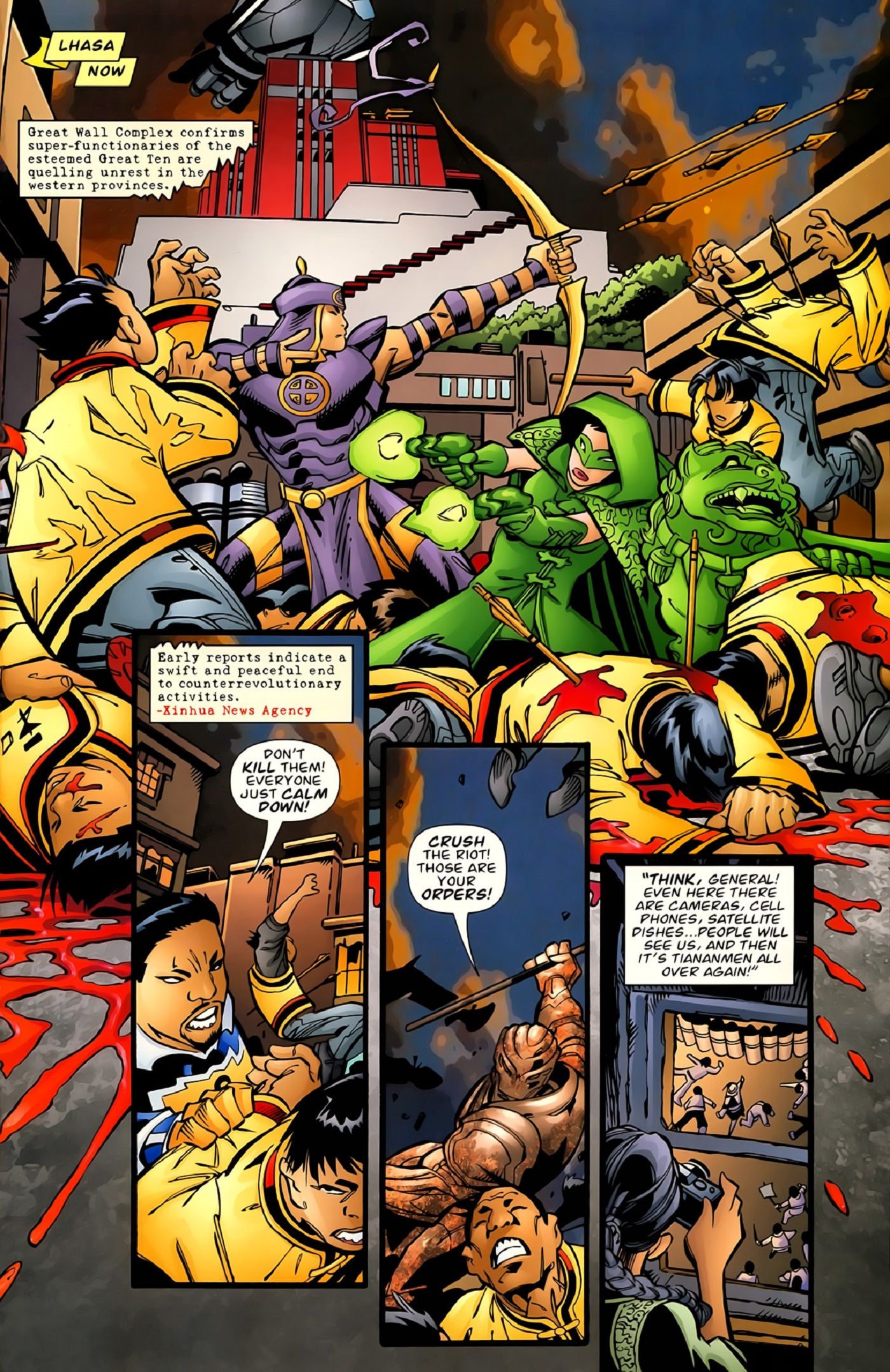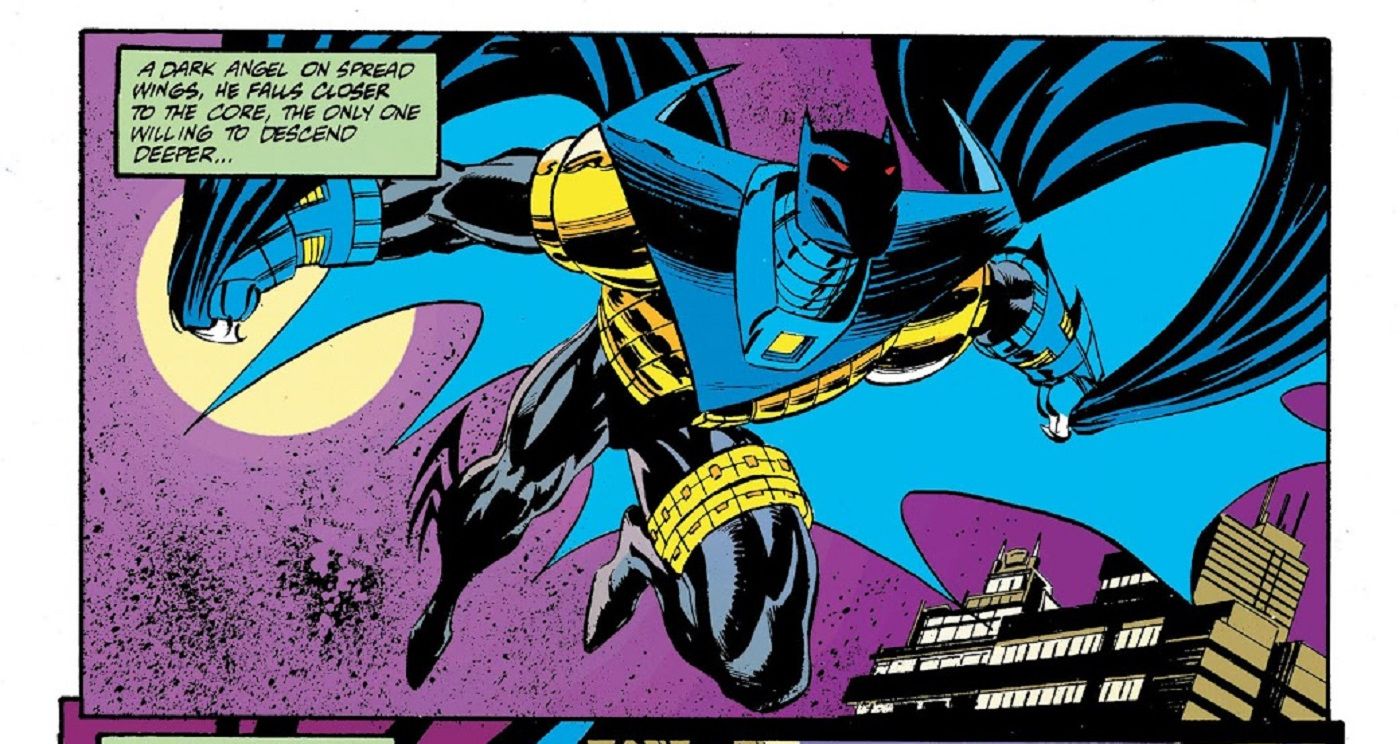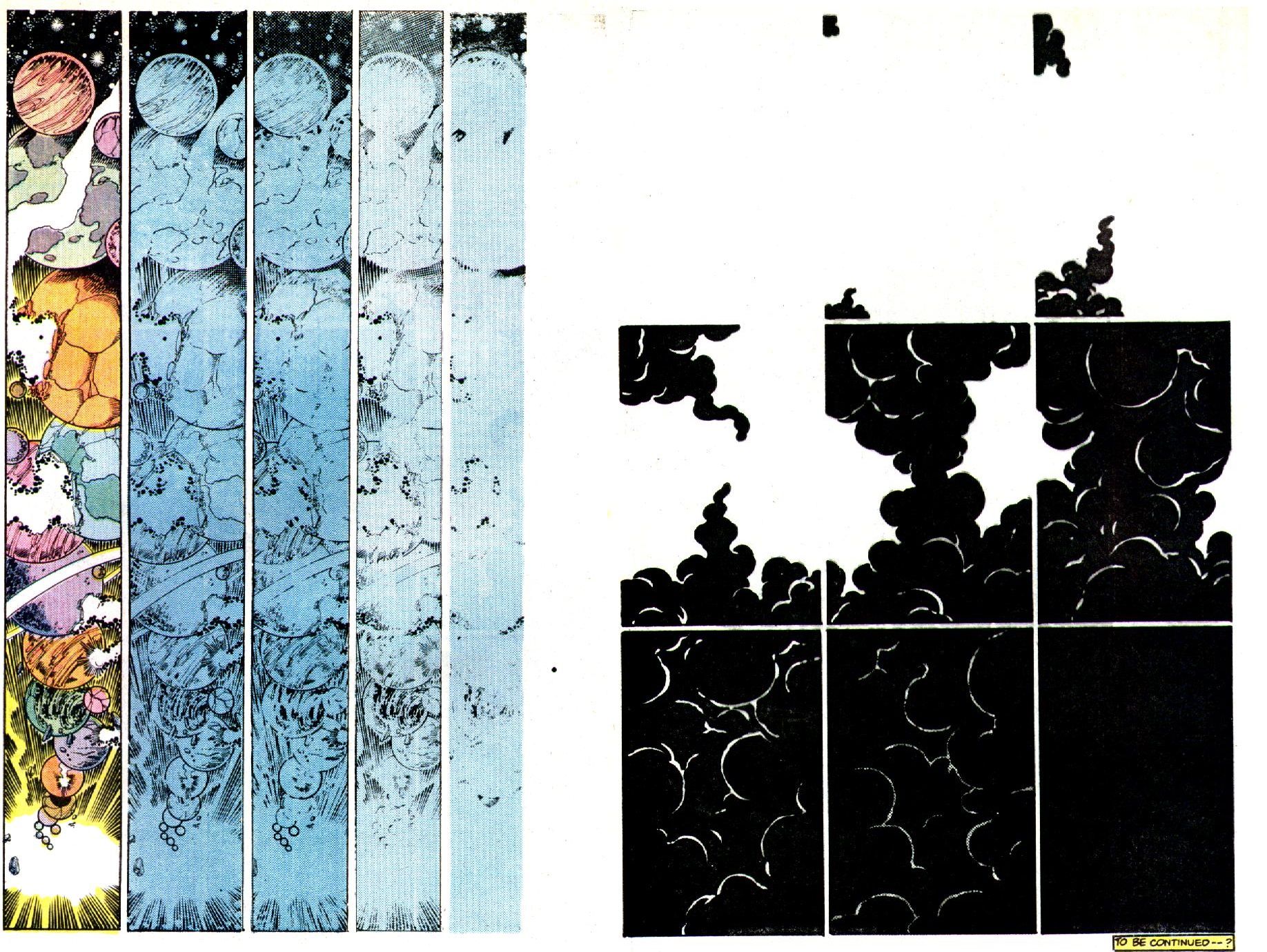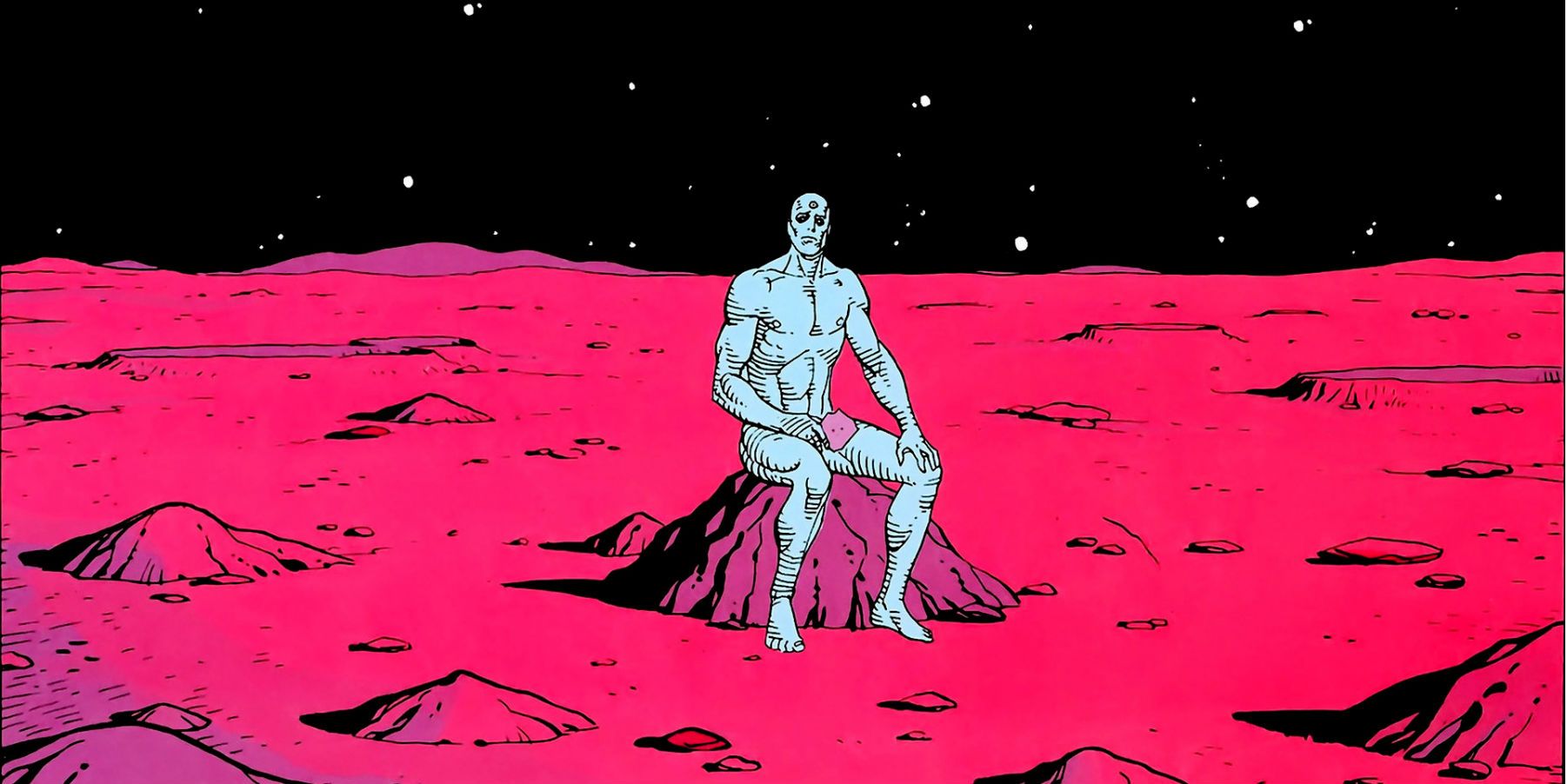Doomsday Clock 2 of 12 Gary Frank Yellow Blue
WARNING: This article contains major spoilers for Doomsday Clock issue #12, on sale now.
Here we are at last, eleven issues and two years later, closing a big chapter of DC Comics' publishing history. In the spring of 2016, DC announced that its New 52 style of superhero comics would develop into a more familiar, more traditional approach to characters and storytelling. The end of May 2016's DC Universe: Rebirth one-shot then revealed that the previously-off-limits world of Watchmen would intersect with DC's larger shared universe. After various teases, tie-ins and continuity tweaks, Doomsday Clock issue #1 came along in November 2017. While it might have lost some relevance to the larger DC metaverse (because the Justice Society has already reappeared in the pages of Justice League, and the Legion of Super-Heroes have their own series once again), Doomsday Clock issue #12 issue is a nice wrap-up.
Because it's also an oversized final issue, Doomsday Clock #12 provides even more space for the kind of details we have come to expect. Therefore, buckle up one last time, grab your copy, prepare for MAJOR SPOILERS and let's go!
Based on Alan Moore and Dave Gibbons' classic 12-issue series Watchmen, Doomsday Clock issue #12 was written by Geoff Johns, drawn by Gary Frank, colored by Brad Anderson and lettered by Rob Leigh. Amie Brockway-Metcalf designed the text pages. Brian Cunningham was the Editor, with Amedeo Turturro as Associate Editor.
United Nations Of Beatdown (Pages 2-4, 8-9, 32)

Superman's solitary fight against Black Adam's crew and the People's Heroes takes up a sizable chunk of this issue, and it gives us a chance to see the characters listed in the text pages of issues #5 and #6.
(Speaking of which, a while back we noted that, because D-Clock was emulating Watchmen's relatively low-key plotting, "a story which is about the creation of literal super-armies doesn't appear likely to end with such a super-battle." Turns out we were wrong. In fact, we were also wrong with the somewhat contradictory theory that Saturn Girl was the evil Saturn Queen and would lead the Legion of Super-Villains into a big battle against DC-Earth's super-armies.)
Anyway, we covered the creator credits for many of these folks back in the annotations for those issues, so thankfully we don't have to go through all that again.

We met several of the People's Heroes on-panel back in issue #5, and most of them have come back for this issue's Page 2. Specifically, we see Lady Flash, Vostok-X, Black Eagle (presumably that's who the black wing belongs to), Negative Woman, Pozhar, three members of Soyuz (Rusalka, Vikhor and Perun) and Tundra (the white-haired woman). They're joined by Markovia's Outsiders, represented by Baroness Bedlam (in the background with the yellow shoulder strap – she gets more of a closeup on Page 9), Geo-Force, Terra, and Wylde (the bear). We're guessing that whoever's in the Azrael-Batman costume is called "Knightfall," because he's listed back in issue #5's text pages as a member of Markovia's Outsiders team. That Batman costume was designed by Mike Manley and first appeared in October 1993's Batman issue #500.
Page 3 brings in Black Adam and Giganta, who seem to have defeated Wonder Woman when they showed up at the United Nations. Issue 11 mentioned that the Amazons "abducted" Wonder Woman, presumably to heal her on Themyscira. As we've seen previously, Black Adam's team also includes Killer Frost, the Cheetah and a Manhunter.
On Page 4, some friendly heroes start riding to the rescue, including Britain's Knight and Squire, Godiva, and Canterbury Cricket. From Australia come Tasmanian Devil, Argonaut, Dark Ranger, Umbaluru (who wasn't really a superhero in the first place), and Betty Clawman. Israel sends Hayoth members Seraph, Pterodon, Judith (holding the sword), Ramban (in blue and white robes), Golem and Dybbuk (the greenish guy bringing up the rear).
According to the Wikipedia, the Australian Protectionist Party is "focused on economic protectionism and white nationalism," and although it's still active, it hasn't been registered as a federal political party since 2015. Furthermore, Benjamin "Bibi" Netanyahu (born October 21, 1949) is Israel's current Prime Minister, having served in that capacity from 1996 to 1999, and currently since 2009.
When the battle really gets going on Pages 8-9, it incorporates more international super-folk. China's Super-Man flies in from the top of the page towards Giganta, who's facing off against Goraiko as Celestial Archer soars past her leg and Solstice hovers nearby. From the left edge of Page 8 the Canterbury Cricket appears to pounce on Jack O'Lantern. The purple dinosaur is likely one form of Animal-Vegetable-Mineral Man, who stands over Silent Knight. Rampage is in the bottom left corner, obscuring most of Godiva (in the white suit with the long blonde hair). Terra seems to be fighting Sandstorm, with Umbaluru caught in the middle; while Golem squares off against Hammersuit Zero-X. We're not sure whose tail that is, but it might belong to Copperhead. If so, Bob Haney and Bob Brown created the reptilian rogue for June 1968's Brave and the Bold issue #78.
France's Fleur-de-Lys draws her pistol as Judith confronts Boss Bishonen. FDL's purple outfit first appeared in January 1994's Deathstroke the Terminator issue #32, which was written by Marv Wolfman and pencilled by Steve Erwin. It comes from her time with France's Department Gamma, so she's clearly here in an official capacity.
On Page 9, Black Adam attacks Goraiko while Pterodon flies beneath. Celsius prepares to zap Baroness Bedlam as The Hood (in the full-face mask) lurks nearby. Dao takes a swing at Judomaster III as Sirocco rushes in and Gloss reaches out. Wylde looks like he's battling the Hyena with the elephant-headed Aalok in the background and Lady Clayface falling off the right edge of the page. Those blue metallic boots belong to the Manhunter. Vostok crashes into the building as Ghost Fox Killer watches and Rising Sun falls headfirst. Finally, the man in the trench coat appears to be Stalnoivolk, the guy with the glowing red eyes is Nazo Baluda, and we're not sure who's being thrown upside-down by that explosion.
Despite Red Star being one of DC's most prominent Russian superheroes, he doesn't really make an appearance here until Page 32.
Barbers, Batman, Luthor, Cars (Pages 5, 14-16, 21-23, 33)

"Ali Barber" (Page 5) is a cute name for a barbershop, perhaps next door to Bob's Burgers. We weren't sure that barber poles were still a thing, but we're glad to see such a retro detail regardless. However, along the same lines, we're a little puzzled to see an old-style boxy square TV set on Page 7. In fact, we kind of get the feeling that TV sets which are always on in store windows (frequently offering helpful exposition) are only seen in stories.
Page 14's "vibrational emitter" seems like a reasonable bit of DC technology that probably hasn't appeared before this issue. We suppose it's based on the notion that every parallel world vibrates at its own unique frequency, so that once you get synced up with your home universe, you go back there.
Pages 15 and 16 offer some pretty on-brand Batman philosophy. "Mak[ing] people see something else" besides a monster goes along with criminals fearing the Bat-trappings and the rest of the citizenry taking comfort in them. Batman saying Mothman "just wanted to protect how [Reggie] remembered [his] father" ties directly into Bruce's parental issues. It's also kind of ironic, considering that Batman probably hasn't learned that the Flashpoint Thomas Wayne/Batman has teamed up with Bane.
You might think we couldn't make a reference out of the fade to black on Pages 21-23, but you would be wrong, quantum-breath! We were reminded instantly of the closing pages of July 1985's Crisis On Infinite Earths issue #4, when the destruction of Earth-One and -Two faded to white and then ended in ominous black clouds.
"A 1927 Ford," as mentioned on Page 33, would probably have been a Model A, and probably wouldn't have looked much like the car from Action issue #1.
How To Get To Manhattan (Pages 12-14, 19, 26, 33, 35)

Doctor Manhattan says on Page 14 that he didn't realize "the illusion would one day end." This raises the obvious point that stories are meant to end, because a story's end tells you what you're supposed to take away from it. A work which stands alone doesn't require any follow-up.
Ironically, for all we say about Watchmen being marvelously self-contained, neither requiring nor inviting a sequel, one of its main themes is the clockwork nature of the world. It continues whether we want it to or not. Veidt can engineer all the squids he wants, but Seymour can blow it all up again. Dr. M's discovery of the Metaverse, and Superman's role therein, is a similar revelation because it describes a universe designed to go on forever.
Of course, for us readers this perpetual existence is the cynical byproduct of corporately-owned intellectual property, including the Watchmen characters (who, for example, may also continue on HBO without producer/writer Damon Lindelof). The most charitable way to look at this is probably the way that Johns and Frank have chosen: As long as people use these characters to add positively to the culture, then they'll continue to thrive. Doctor Manhattan tells us that Superman will exist for at least another thousand years, and will continue to bring hope to all he encounters throughout that time. You don't get much more positive than that, but by the same token you don't get new Superman stories for a millennium unless the character gets passed down like a family heirloom.
In hindsight, it was also probably inevitable that these two worlds would collide. Over two years ago, shortly before D-Clock's first issue had come out, we kind of thought Superman would give Doctor Manhattan some emotional support. Back then we said that "Doomsday Clock will be Geoff Johns and Gary Frank's attempt to put Superman-style ethics to the ultimate test. [...] If there is one theme which runs throughout Geoff Johns' recent DC work, it is that no character is beyond rehabilitation. [...] No matter how bad it gets, the characters themselves contain the seeds of their own salvation. In this respect, if superheroes are part of what ails Watchmen's world, then why can't the 'real' Superman help save it?"
That seems to have been borne out. This whole issue strikes us as a companion piece to Watchmen issue #9, where Doctor Manhattan's conversation with Laurie Juspeczyk ends with his revelation about the thermodynamic miracle. After all, that's the part of Watchmen which convinces Dr. M that (his) Earth is worth saving. Here, what does the trick is the combination of his memories of Janey Slater and his experiences with the once and future Superman. It's not so much that Dr. M has regressed emotionally, but that once again he's apparently having trouble seeing the value in altruism. Indeed, on Page 13 he tells Supes "I don't help you." In a sense that's true, because he doesn't help Supes directly (by, say, popping Black Adam's head like a balloon). What he does instead is undo all the changes he made to the Metaverse's overall timeline, thereby allowing it to unfold and develop on its own. The existence of multiple rocketship landings throughout Earth history would seem to create multiple variant timelines, such that the Metaverse contains its own multiverse, where there's been a Superman as long as there has been a kindly couple to raise him. (We're not reminded of any specific Elseworlds in those brief glimpses, by the way.) Thus, on Page 26 we might be seeing the Kents of Earth-52 (named on Page 33) in panel 1, and the Kents of the restored timeline starting in panel 3.
On Page 2 Doctor Manhattan calls Superman the Metaverse's "greatest antibody," and Dr. M does end up succumbing to the inevitability of Superman's innate optimism. The line on Page 35 about Superman being "the bridge across generations that will lead everyone to peace" is pretty treacly, but given Superman's once-and-future treatment as the superheroic ideal, it's almost inescapable. If indeed Superman is rebooted endlessly for the next thousand years, odds are his future handlers will keep coming back to the hope at the core of Jerry Siegel and Joe Shuster's original work. Certainly that's a very positive spin on what can be a very exploitative practice.
In any event, on Page 19 Superman tells Dr. M that instead of a binary choice between one or the other of them surviving, he can choose instead to sacrifice himself. This version of Supes gave "all he had" to stop Doomsday in January 1993's Superman issue #75, which of course came out on November 18, 1992, a few days "before" Doomsday Clock issue #1's opening scenes on Watchmen's world.
Otherwise, the excerpts of Doctor Manhattan's history from Watchmen issue #4 are pretty faithful. We had forgotten the part about waiting for Janey Slater's mother, but it's in the original. Also, surely Dr. M is reminded of April 18, 1938 when he sees Supes catch that Mercedes on Page 12.
More to come in Part 2, including the Legion, the Justice Society and much more Metaverse!
We're exhausted! Tell us what else you saw in the comments!
Source: https://www.cbr.com/doomsday-clock-12-annotated-part-1/
0 Response to "Doomsday Clock 2 of 12 Gary Frank Yellow Blue"
Post a Comment